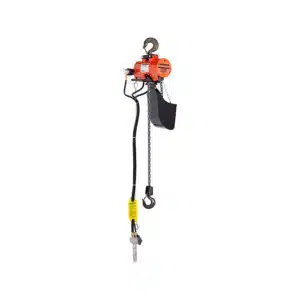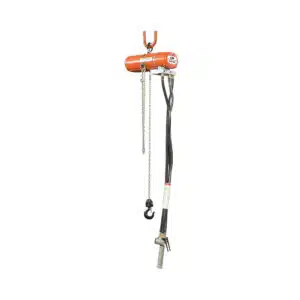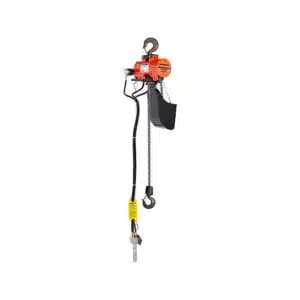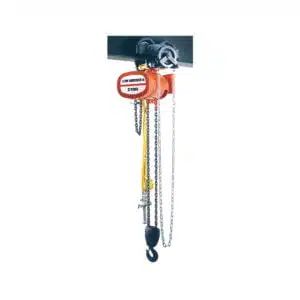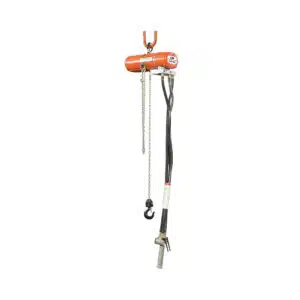Air Chain Hoists
AirStar
ShopAir
CM AirStar & ShopAir: What’s The Difference?
The CM AirStar offers precise load control and safety in potentially hazardous conditions due to its variable speed and spark-resistant options. In contrast, the CM ShopAir is designed for high-volume, fast-paced industrial settings like production lines.
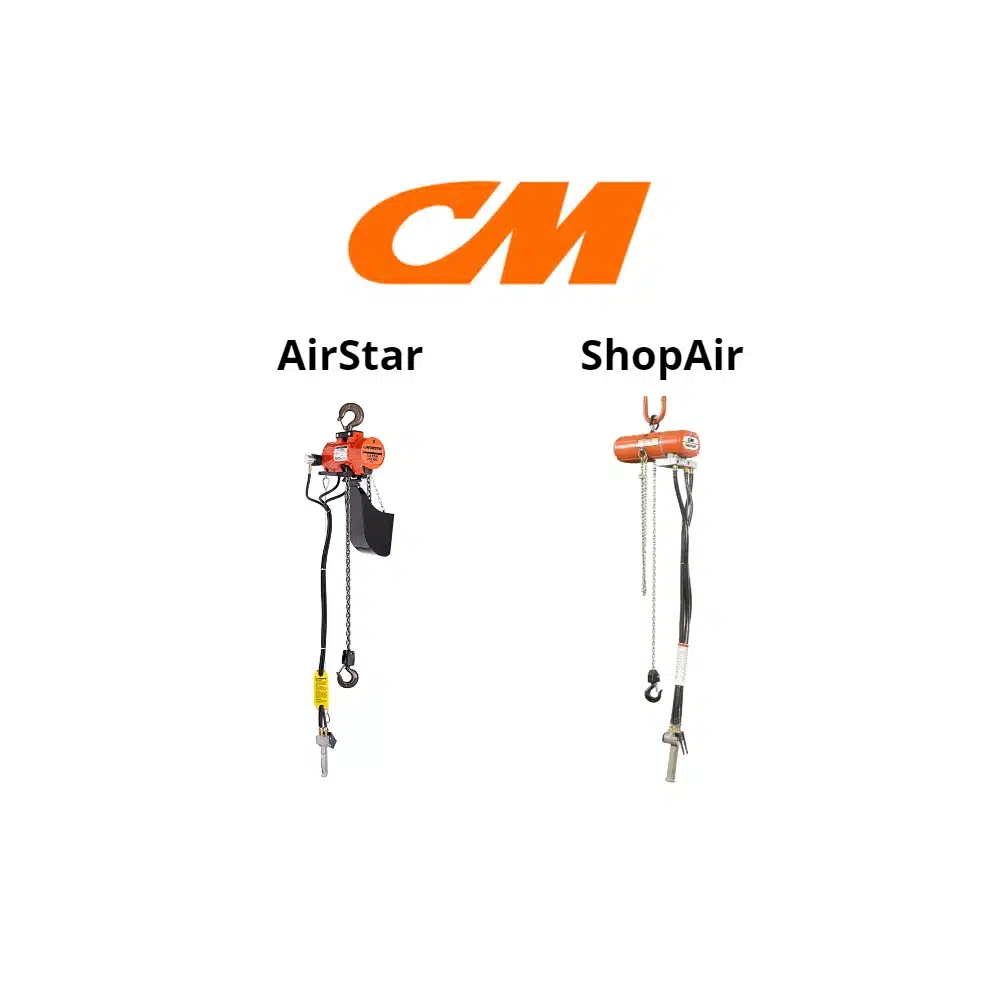
Initial Thoughts
Choosing the right air chain hoist for your industrial needs isn’t just a matter of selecting the most affordable or the first option you come across. It requires careful consideration of various factors, such as lifting capacity, speed, control mechanisms, and suitability for specific environments.
In the world of air chain hoists, two prominent models often come to mind: the CM AirStar and the CM ShopAir. Both products are manufactured by Columbus McKinnon, a leader in the hoist and rigging industry, known for their reliable and innovative lifting solutions.
This guide was made to showcase the differences between the CM AirStar and the CM ShopAir. By examining their features, capabilities, and ideal usage scenarios, we will provide a comprehensive guide to help you determine which hoist is best suited for your operations.
Overview of CM AirStar
The CM AirStar air chain hoist stands out in the industrial lifting sector, combining a lightweight, compact design with powerful functionality. Engineered for a variety of applications, it excels in environments where variable speed and precise load control are necessary. Let’s explore the design, capabilities, and distinctive features that make the CM AirStar a preferred choice for precise and safe lifting operations.
Design and Construction
- Lightweight and Portable: Features an aluminum frame and cover, making it easy to transport and install without sacrificing durability.
- Robust Build: Despite its portability, the AirStar is built to endure tough industrial conditions over long periods.
Capacities and Applications
- Versatile Lifting Capacities: Handles loads from small to medium sizes, with capacities up to 1 ton, suitable for a wide range of applications.
- Ideal for Various Settings: Especially useful in assembly lines, maintenance facilities, and any area requiring precise load manipulation.
Features and Functionality
- Control Options: Offers both pull cord and pendant throttle controls, allowing for:
- Precise load manipulation
- Exact positioning necessary for specific operational requirements
- Spark-Resistant Models: Enhances safety in potentially explosive environments by preventing ignition sources.
- Advanced Brake System: Incorporates a heavy-duty shoe-type brake for reliable load holding and safety.
- Noise Reduction: An internal muffler lowers operational noise, making it suitable for quieter environments.
Benefits
- Efficiency and Safety: Designed to boost productivity while ensuring operational safety.
- Lifetime Warranty: Backed by a lifetime warranty, highlighting Columbus McKinnon’s commitment to quality and customer satisfaction.
Overview of CM ShopAir
The CM ShopAir air chain hoist is a robust tool designed for both workstation and production line applications. Known for its superior lifting speeds and compact design, the ShopAir is ideal for continuous industrial use where precise load spotting and durability are key. Let’s take a look at the hoist’s main features, design elements, and its practical benefits in industrial environments.
Design and Construction
- Compact and Rugged: The ShopAir is built with a durable cast aluminum alloy frame, making it tough yet manageable for daily operations.
- Portable Design: Its small size and lighter weight make it highly suitable for various workstation applications where space and ease of movement are critical.
Capacities and Applications
- Broad Range of Capacities: Designed to handle loads ranging from small to medium sizes, with specific models tailored for different operational needs.
- Workstation Optimization: Particularly effective as a workstation or production line hoist, providing reliable performance in repetitive lifting tasks.
Features and Functionality
- Control and Speed: Features a variable flow, two-lever pendant that allows for precise load spotting—an essential feature for detailed and delicate operations.
- Safety and Overload Protection: Equipped with a standard Protector™ overload device, ensuring that the hoist operates within its capacity to prevent mechanical overloading.
- Environmental Adaptability: Includes threaded external exhausts for clean room or painting applications, where managing environmental contaminants is necessary.
Benefits
- Enhanced Productivity: The ShopAir’s high lift speed and ease of control significantly boost operational efficiency and reduce downtime.
- Versatility: Its adaptability to different industrial environments makes it a versatile choice for a variety of businesses needing reliable lifting solutions.
- Longevity and Maintenance: Engineered for easy maintenance, with features like lifetime lubricated gear trains and durable reduction gearing, ensuring long-term reliability and lower upkeep costs.
CM AirStar & ShopAir Hoists For Sale
Comparative Analysis: AirStar versus ShopAir
When choosing between the CM AirStar and the CM ShopAir air chain hoists, it’s essential to understand their distinct features and how these cater to different industrial needs. Here is a detailed comparison based on their design, capabilities, control options, and typical use cases, helping you decide which hoist is best suited for your specific requirements.
Lifting Capacity and Speed
- AirStar: Known for its variable speed settings, the AirStar offers precise control, making it ideal for environments where delicate handling and exact positioning are required. It typically handles up to 1 ton, suitable for lighter, more precise tasks.
- ShopAir: In contrast, the ShopAir is designed for somewhat heavier-duty applications with similar capacity limits but is favored for its superior lifting speed. This makes it particularly effective in production lines where efficiency and quick operation are critical.
Design and Portability
- AirStar: Features a lightweight aluminum frame that enhances its portability without compromising on durability. Its compact design allows for easy installation in various industrial settings.
- ShopAir: While also compact, the ShopAir is specifically designed for rugged industrial environments. Its cast aluminum alloy frame ensures it can withstand the rigorous demands of continuous operation.
Control Mechanisms
- AirStar: Offers both pull cord and pendant throttle controls, providing flexibility in operation style according to the precision required in the task. Spark-resistant models add a layer of safety in hazardous environments.
- ShopAir: Equipped with a variable flow, two-lever pendant for precise load spotting, the ShopAir focuses on providing control and safety through its standard Protector™ overload device, which prevents overloading and enhances operational safety.
Environmental Suitability
- AirStar: The availability of spark-resistant models makes the AirStar suitable for use in hazardous environments where there is a risk of flammable gases or dust.
- ShopAir: Features like the threaded external exhaust for piping away exhaust in clean rooms or painting applications make it ideal for environments that require maintaining cleanliness or managing environmental contaminants.
Durability and Maintenance
- AirStar: Designed with a focus on low maintenance needs and durability, the AirStar includes features like an internal muffler to reduce noise, making it suitable for quieter, cleaner operations.
- ShopAir: Its rugged design and industrial duty air motor are built for tough applications, with a gear train that is lifetime lubricated with non-oxidizing grease, emphasizing less frequent maintenance and longevity.
Case Studies
To further illustrate the practical applications and benefits of the CM AirStar and ShopAir hoists, let’s explore a few case studies that showcase these models in real-world settings. These examples highlight how different industries utilize these hoists to enhance efficiency, safety, and productivity in their operations.
Case Study 1: Automotive Assembly Line – ShopAir
In a large automotive manufacturing facility, the ShopAir hoist was implemented to improve the assembly line’s efficiency. The ShopAir’s superior lifting speed and rugged design made it ideal for handling the frequent lifting of heavy car parts.
The two-lever pendant control allowed operators to precisely position components, which was crucial for maintaining a fast-paced production schedule. The integration of the ShopAir hoist resulted in a noticeable reduction in downtime and a smoother workflow, demonstrating its value in high-demand industrial environments.
Case Study 2: Chemical Processing Plant – AirStar
A chemical processing plant required a reliable hoisting solution that could operate safely in a potentially explosive atmosphere. The AirStar, with its spark-resistant features, was chosen to mitigate risks of igniting flammable gases during material handling processes.
The hoist’s variable speed settings allowed workers to carefully manage the movement of sensitive chemical containers, enhancing safety and compliance with stringent industry regulations. This case study underlines the AirStar’s critical role in maintaining operational safety in hazardous environments.
Case Study 3: Food and Beverage Distribution Center – ShopAir
In a food and beverage distribution center, the ShopAir hoist was utilized to optimize the storage and handling of large pallets of goods. The hoist’s robust construction and quick lifting capabilities enabled the center to maximize space utilization by efficiently stacking goods in high shelving units.
The ShopAir’s reliability and speed helped the facility maintain a high throughput, crucial for managing perishable goods and meeting tight delivery schedules.
Case Study 4: Aerospace Component Fabrication – AirStar
The aerospace industry demands precision and reliability, where the AirStar hoist was employed to handle delicate components. The hoist’s precise control mechanisms were essential for the careful assembly of aerospace parts, which require meticulous handling to avoid damage.
The lightweight and compact design of the AirStar also facilitated its integration into the facility’s existing workspace, where precision and space efficiency are paramount.
Maintenance and Safety Guidelines
Proper maintenance and adherence to safety guidelines are crucial for ensuring the longevity and safe operation of air chain hoists like the CM AirStar and ShopAir. Regular maintenance not only extends the life of the equipment but also prevents accidents and improves efficiency. Below are essential tips and guidelines for maintaining these hoists and ensuring they are operated safely.
Routine Maintenance
- Lubrication: Regular lubrication of the chain and other moving parts is vital. Use the manufacturer-recommended lubricant to ensure smooth operation and to prevent wear and tear.
- Inspection: Conduct regular inspections to check for signs of wear or damage in the chain, hooks, and housing. Look for any distorted, stretched, or cracked components, and replace them as necessary.
- Cleaning: Keep the hoist clean from dirt and debris, which can accumulate and affect its performance. Ensure that the air intake is clear to maintain optimal air flow for the motor.
Safety Guidelines
- Training: Ensure that all operators are properly trained on the use of the hoist, including understanding how to control the hoist accurately and how to respond in case of an emergency.
- Load Capacity: Never exceed the recommended load capacity of the hoist. Overloading can lead to equipment failure and pose serious safety risks.
- Operational Checks: Before using the hoist, perform operational checks to ensure all controls are working correctly and the hoist responds as expected.
- Use of Controls: Familiarize operators with the control options—whether pull cord or pendant throttle—and ensure they use them according to the manufacturer’s instructions to avoid abrupt or uncontrolled movements.
Environmental Considerations
- Hazardous Locations: For hoists used in hazardous environments, such as the AirStar’s spark-resistant models, ensure that all environmental and operational guidelines are strictly followed to prevent accidents.
- Exhaust Management: For the ShopAir, make sure that the exhaust is properly managed, especially in environments like clean rooms or when painting, to avoid contamination.
Regular Testing and Certification
- Load Testing: Conduct load testing periodically to ensure the hoist can handle the maximum rated load safely.
- Certification and Compliance: Keep up with all required safety certifications and compliance checks to meet industry standards and legal requirements.
How To Choose: AirStar or ShopAir?
When selecting the right air chain hoist for your operations, deciding between the CM AirStar and the CM ShopAir involves considering several factors. These include the specific requirements of your operational environment, the nature of the tasks the hoist will perform, and the particular features that each model offers. Here’s a guide to help you make an informed decision between these two models.
Assess Your Lifting Needs
- Capacity and Size: Determine the weight and size of the loads you typically handle. The AirStar is ideal for precise lifting of lighter loads up to 1 ton, making it suitable for delicate or hazardous environments. In contrast, the ShopAir, while also capable of handling up to 1 ton, offers faster lifting speeds and is more rugged, designed for repetitive use in industrial settings.
- Operational Frequency: Consider how often the hoist will be used. The ShopAir’s design caters to high-duty cycles and continuous use, making it better suited for production lines. The AirStar, while durable, is optimal for environments where variable speed and control are more critical than constant operation.
Consider the Operating Environment
- Workplace Conditions: Evaluate the conditions under which the hoist will operate. For environments with potential explosive gases or combustible dust, the AirStar’s spark-resistant models are indispensable. If the hoist will be used in a clean room or a painting area, the ShopAir’s features that allow for exhaust management could be crucial.
- Space Constraints: Analyze the space available for installing the hoist. Both hoists are compact, but the AirStar’s particularly lightweight design might be more suitable for smaller or more confined spaces.
Evaluate Additional Features
- Control Systems: The type of control system can impact operator ease and safety. The AirStar provides options for either pull cord or pendant controls, offering precision that is beneficial in settings requiring exact positioning. The ShopAir’s pendant control with variable flow is ideal for environments where precise load spotting is necessary at a quicker pace.
- Maintenance and Longevity: Consider the maintenance requirements and the expected longevity of the hoist. Both models are built to last, but the ShopAir’s features like its industrial-duty air motor and lifetime lubricated gears are particularly designed for longevity in more demanding industrial applications.
Budget and After-Sales Support
- Initial Cost vs. Return on Investment: Weigh the initial cost against the expected benefits such as improved efficiency, reduced downtime, and lower maintenance costs.
- Warranty and Support: Check the warranty and the manufacturer’s support services. Both models come with significant warranties and support, but specifics may vary and can influence the decision based on how critical uptime is to your operations.
Choosing the Right Hoist
Deciding between the AirStar and the ShopAir will largely depend on your specific industrial needs:
- Choose AirStar if your operations require high precision, variable speeds, and potentially involve hazardous environments.
- Opt for ShopAir if your priority is speed, efficiency, and robustness in more demanding production line environments.
Final Thoughts
The CM AirStar excels in environments requiring precise load control and safe operation in potentially hazardous conditions. Its variable speed settings and spark-resistant options make it ideal for delicate or dangerous tasks.
On the other hand, the CM ShopAir is particularly suited for high-volume, fast-paced settings like production lines, where its superior lifting speed and rugged design can handle the demands of continuous operation.
When choosing a hoist, consider the nature of your tasks, the typical load sizes, the frequency of use, and the specific conditions of your work environment. It’s also important to evaluate the ease of maintenance, control system preferences, and overall cost-effectiveness, including potential return on investment.

